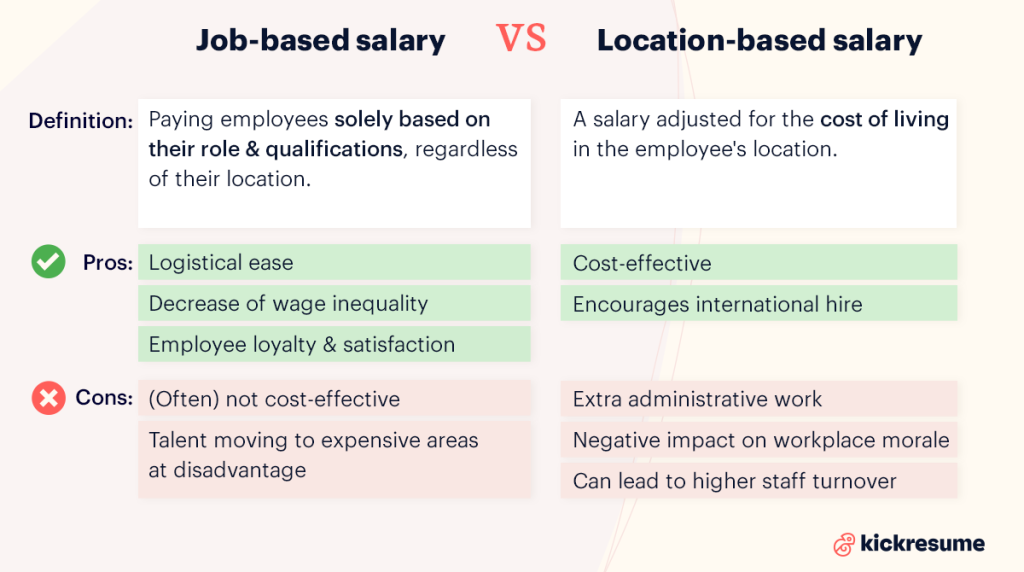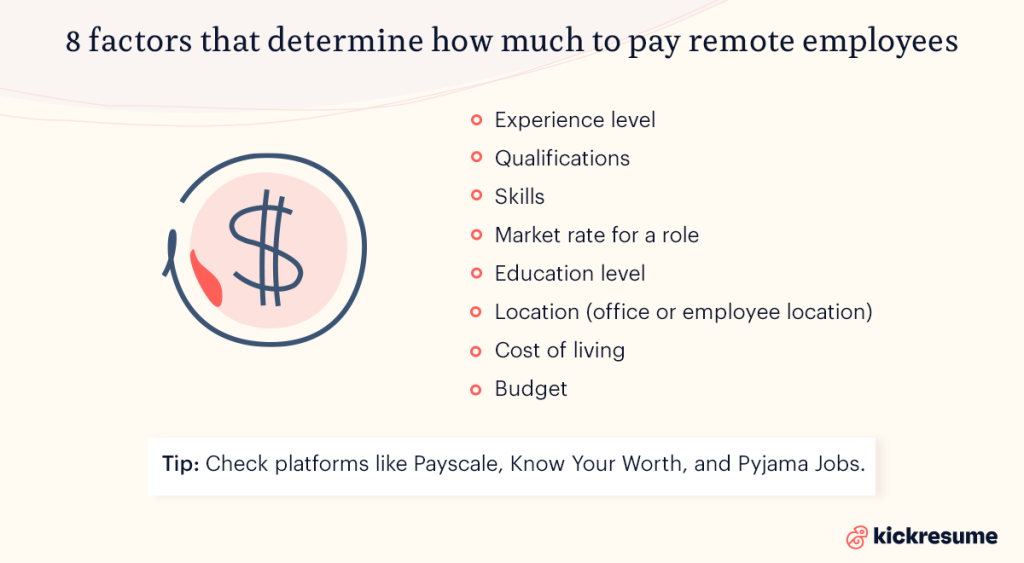It's estimated that by 2025, 70% of the workforce will work remotely to some degree. Yet, most companies still struggle with how to pay remote employees.
Furthermore, employees who feel underpaid are 49.7% more likely to search for a new job than those whose salary is in line with or above the market rate, according to a Payscale report.
But, when hiring remotely, it can be difficult to determine the market rate for a role when it varies so much depending on the geographical location.
In this article, we'll look at the two primary ways to pay remote employees: location-based and job-based salaries.
We'll talk about the pros and cons of each and explore the different factors you should consider when deciding how to pay your remote workers.
- Difference between salaries for in-house and remote employees
- Remote payroll: location-based vs. job-based salary
- Job-based remote salary
- Location-based remote salary
- How to calculate pay for remote employees?
- How to pay remote employees?
- What are the best payment methods and online platforms for remote pay?
- When to pay remote employees
- Which currency to pay your remote employees
- What benefits to offer to remote employees
Difference between salaries for in-house and remote employees
One of the most important considerations when hiring employees is the salary.
Determining the wage for office-based workers is traditionally based on factors such as:
- their experience
- skills
- the market rate for a given role
- education level
- and the adjustment for the company (or office) location
Many companies leverage outsourced payroll to handle these standardized calculations, but when it comes to remote workers, the deciding factors should be the same.
Additionally, in-house employees have other expenses like the cost of commuting or childcare.
When it comes to remote workers, the deciding factors should be the same.
Even though the additional expenses for commuting become irrelevant for remote employees, other expenses, such as the cost of electricity or technological equipment, come into play.
However, the location factor becomes a bit more problematic.
Let's say your company is based in San Francisco, California, where the average cost of living (COL) is very high. One of your employees relocates to Iowa, where COL is comparatively lower.
You can either decide to pay the remote employee the same wage you'd pay them if they were based in San Francisco or adjust their salary to the cost of living in Iowa.
In other words, either pay them a job-based salary or a location-based salary.
The decision is ultimately up to you. However, there are certain pros and cons to both approaches. Let's examine them more closely.

Remote payroll: location-based vs. job-based salary
As mentioned, there are two main ways to pay remote employees: location-based and job-based salaries.
- A job-based (role-based) salary for remote employees means that you're paying them solely based on their qualifications and role, regardless of their location. For example, Buffer, a social media management platform, is a big advocate for job-based salaries because of its simplicity and transparency.
- A location-based salary for remote workers is adjusted for the cost of living in the employee's location. You take into account factors such as the cost of housing, transportation, and health care. Facebook and Google are among the companies paying a location-based salary to their remote workers.
There's no single answer as for which of these methods for paying remote staff is superior. Both have their advantages and pitfalls. It's up to you as an employer to decide what compromises you're willing to make.
We're here to guide you through the details of each of these methods so you can make an informed decision on how to pay remote employees.
Job-based remote salary
First, let's have a look at the less complex way how companies set salaries for remote jobs — job-based salaries.
Pros of job-based remote salary:
- Logistical ease. The biggest benefit for companies is the logistical ease of this method. Essentially, everyone gets paid the same, regardless of where they're based. And, even if remote employees move, you don’t need to adjust their salaries to fit their new location.
- Reduces wage inequality among employees. Job-based salaries help to create a sense of team unity among employees, both remote and office-based, since they’re all being compensated the same.
- Increases employee loyalty and satisfaction. If employees decide to relocate and are allowed to keep their salary, they have no reason to look for a new job. They know they're being compensated fairly for their role. This leads to a positive work environment and increased employee morale.
Cons of job-based remote salary:
- It's (often) not cost-effective for the company. The truth is that out of the two main methods, this one is often less cost-effective. If your employee relocates to an area with a lower COL and you don't decrease their salary, you'll end up spending more on the payroll than if you adjusted their salary. Plus, if you're outsourcing employees in a cheaper labor market and pay them the same as their higher COL colleagues, you may end up overspending on salaries.
- It puts talent living in more expensive areas at a disadvantage. Of course, people don't always relocate to cheaper areas. Sometimes it's the other way around. If your employee moved to an area with a higher COL and their salary remained the same, they'll be more likely to look for a different job.
Location-based remote salary
Now, let's examine the method which uses your location as part of remote payroll calculation.
Pros of location-based remote salary:
- It's cost-effective. By adjusting salaries according to location and the local cost of living, it's possible to avoid overspending on the payroll and cut back on salary costs. Out of the two methods, a location-based pay approach is usually coined as being more cost-effective for companies. Why? Well, it's mostly used by big companies outsourcing their talent in emerging markets (for example, in Asia), allowing them to spend less on salaries.
- It encourages international hires and, thus, expands the talent pool. Global employers can offer competitive salaries that make it easier to attract candidates from different countries.
Cons of location-based remote salary:
- Extra administrative burden. Creating and maintaining a location-based salary system is a very complicated and exhausting process. It requires thorough research on local labor laws, salary rates, and COL indexes. What's more, it needs to be constantly updated to guarantee that the system is valid and in line with any changing regulations. And, of course, if an employee relocates, you must start all over again.
- Negative impact on workplace morale. If employees relocate to areas with a lower COL, they may experience pay cuts. Arguably employees won't welcome this decision with open arms. Moreover, this approach can create competition and bad blood between colleagues in different locations.
- Can lead to higher staff turnover. When employees living in areas with a lower COL learn that their coworkers earn more for doing the same job simply because of location, they'll be more likely to look for a new position.
As you can probably tell, neither one of these two main ways how to pay remote employees is 100% fair.
Therefore, as an employer, you'll need to weigh the pros and cons of each method, be prepared to compromise or implement a hybrid model of remote payroll.

How to calculate pay for remote employees?
Firstly, the calculation of remote payroll depends on which of the two methods — location-based & job-based salary — you choose.
Generally, the factors you'll need to consider include:
- Experience level
- Qualifications
- Skills
- Market rate for a role
- Education level
- Location (whether that's office location or employee location)
- Cost of living
- Budget
Fortunately, there are also resources which help with how to calculate pay for remote employees.
These platforms do the market research for you and help you work out fair and accurate pay for remote workers:
- Payscale. This payroll software and data company helps employers manage employee compensation, and employees understand their worth in the job market. It helps businesses get accurate and real-time information on job market compensation. Hence, it's more focused on how much to pay remote employees. Nestlé is among the companies using Payscale.
- Glassdoor. Their Know Your Worth tool will help you discover what an employee should earn based on their title, company, location, and experience.
- Remote job boards. For instance, Pyjama Jobs is a remote job board that requires employers to provide a salary range for each remote job. There are many out there allowing you to make a quick market research for remote roles in different locations.
How to pay remote employees?
One of the most problematic parts of how to pay remote employees (and specifically international payroll salaries) is understanding legal & administrative things like: local labor laws, payroll laws, taxation policies, permanent establishment risks, employer deductions, local benefits, payroll cycles, etc. Companies sometimes partner with an employer of record to help them with it.
So all this in various countries, might we add. Tedious, right?
Well, luckily, there's software which can help you navigate this.
These are 2 most widely-used international payroll softwares:
- Multiplier. This platform helps companies hire and pay remote workers while complying with local labor and tax laws. It takes care of your global teams’ payroll, taxes, social contributions, labor contracts, local benefits, and local insurance policies. Uber or PwC are amongst the companies that use Multiplier to support their global payroll and compliance.
- Remote. This is another global payroll software developed to assist companies in easily hiring employees from anywhere in the world. They also help in managing their payroll, benefits, taxes, and compliance. Burger King and Aston Martin are among the companies using Remote.
What are the best payment methods and online platforms for remote pay?
Going through with traditional money transfers becomes complicated when working with employees all over the world.
Setting up bank accounts in other countries isn't the easiest solution either.
Luckily, there are plenty of online payment options for remote workers.
While some guarantee the most secure transactions, others facilitate timely and efficient payments.
And some (the first two) even take care of legal & administrative stuff.
However, if you desire to cut down on cost and time, these are some of the best platforms to consider when paying remote workers:
When to pay remote employees
Every country has its own rules and customs for when to pay employees. This is also referred to as pay cycles. And, as a remote employer, you should keep tabs on these.
Depending on the jurisdiction, employers may have the freedom to decide when in a given month to pay their employees (usually, it's bi-weekly, on a particular date, the first day of the month, etc.), but some countries specify country-wide paydays in law.
For example, in the UK, companies must pay on the last date of a month or a few days before then.
In countries like the USA, the pay frequency requirements differ for each individual state. For instance, states like Kansas, Colorado, or Delaware require a monthly payment, while Connecticut requires weekly payments. Most states, however, allow more than one single payroll frequency.
South Korea and The Netherlands have a national payday on the 25th day of the month.
Additionally, some countries have a mandatory 13th month (or even 14th-month pay). In Italy, for example, some companies have a 14th-month settlement, often paid in June.
All in all, the best time to pay remote workers depends on the governing rules practiced in the country where your remote employee resides.
Which currency to pay your remote employees
Most countries' labor laws require you to pay remote employees in the local currency.
However, this can be a challenge due to the volatile nature of the foreign exchange market.
Fluctuations may cause the value of a currency to unexpectedly rise or drop, with the employer usually bearing the cost.
To minimize this risk, employers may specify other currencies in their contracts or set a fixed exchange rate to ensure stability.
What benefits to offer to remote employees
Setting a fair salary is one way to ensure employee satisfaction.
The second way to do so is by offering benefits to your remote employees.
Remote workers require the same level of support from their employers as their on-site coworkers, so you shouldn't forget about it.
Let's look at the top 10 perks, advantages, and benefits available to remote employees:
- Fitness & well-being benefits
- Training and development opportunities
- Insurance plans
- Childcare benefits for remote employees
- Food and drink packages
- Financial equity or stock options
- Tools & technical benefits for remote employees
- Retirement plans
- Home workstation support
- Travel remote employee benefits
If you're interested to learn more about benefits for remote employees, our dedicated article provides a full list of the top 10 benefits, as well as helpful tips and online resources.



